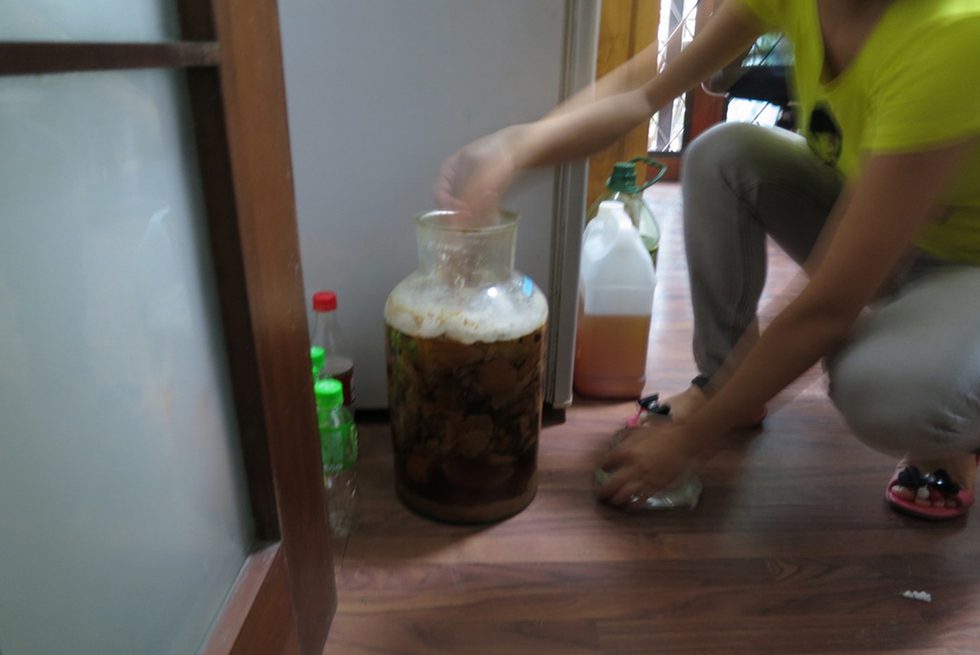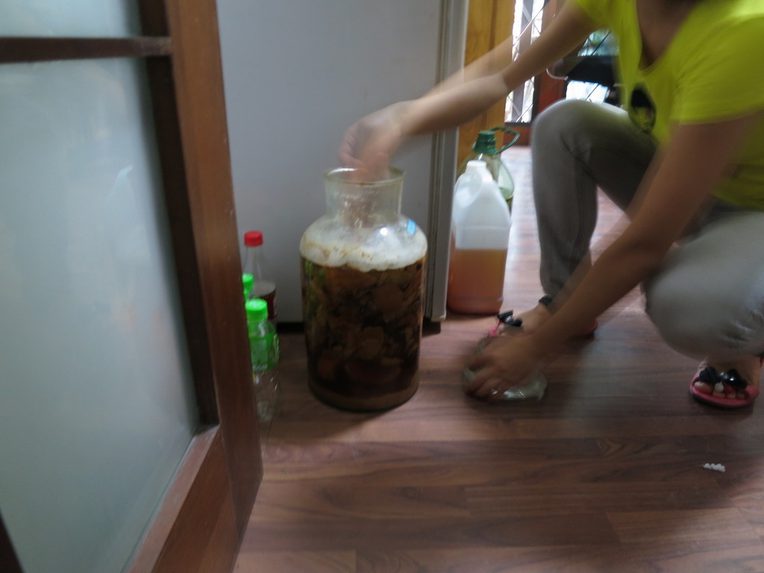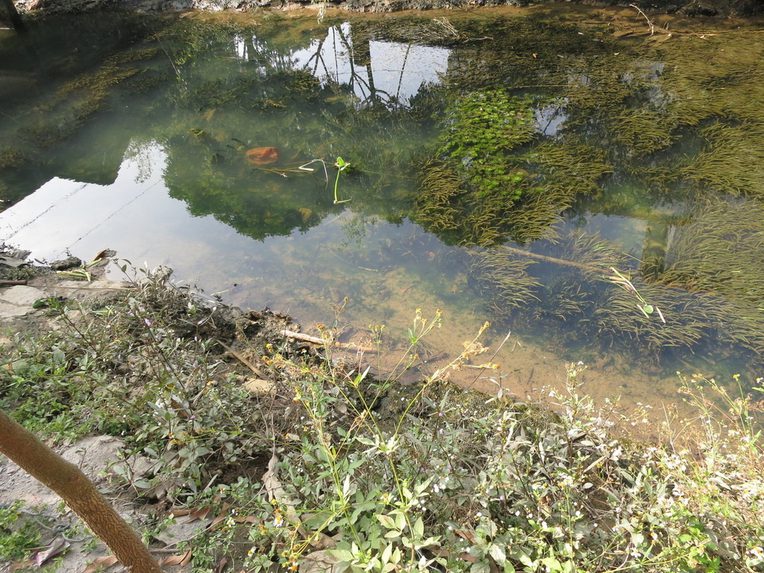(Eco)Enzyme as Catalyst
From the Series: The Naturalization of Work
From the Series: The Naturalization of Work

In 2013, I began attending workshops in a gated community in the Chinese city of Guangzhou, hosted by waste activists who had been involved in a protest against a government proposal to build a waste-to-energy incinerator. Unlike other waste-reduction projects concerned with the responsible stewardship of household objects, such as local flea markets, exchanges of secondhand goods, or battery collection and recycling, organizers of these workshops focused on the brewing of ecoenzymes (huanbaojiaoshu).
Ecoenzymes, also known as garbage enzymes, are a solution made from water, brown sugar, and leftover organic waste, mostly vegetable leaves and fruit peels. Initially popular in Taiwan, Thailand, and Malaysia, ecoenzyme brewing is also gaining popularity in China. The solution is simple to make. Leftover kitchen scraps are cut up and mixed with one part brown sugar, three parts kitchen scraps, and ten parts water. Left to ferment for three months, the resulting cloudy brew is a simple, economical alternative to chemical cleaners, shampoos, and detergents.

In contrast to state plans to build centralized technological facilities to treat waste and community programs aimed at reforming human behavior by promoting recycling or reuse, ecoenzyme DIYers aim to reduce organic waste by caring for and fermenting their garbage. Against the backdrop of a waste crisis and efforts to manage human-generated waste (Gabrys 2013; Reno 2016; Hecht 2018), ecoenzyme adherents believe that waste itself can be turned into a purifying agent.
To make ecoenzymes, home brewers colabor alongside bacteria during the process of fermentation. DIYers carefully monitor the changes to the solution in their jars, looking for evidence of bacteria and microorganisms at work (such as changing colors or built-up gas). After three months, the prepared ecoenzyme solution is put to a wide range of uses. During workshops, I saw adherents rub the solution onto their skin as a rejuvenating serum and bug repellent, spray it on plants as an organic fertilizer, and pour it into rivers to purify chemical pollution.
Participants soon began to ferment not only kitchen scraps but also cocktails of fresh fruit and other herbs to be ingested in order to cleanse the body. They insisted on the efficacy of the ecoenzyme to restore dying plants, to produce sleeker, shinier hair, and to purge visible signs of industrial contamination in rivers. What is remarkable about the practices of ecoenzyme makers, though, is their willingness to let nature work without knowing how nature works. Participants debated the solution’s pH scale and whether, for example, it was the solution’s acidic or basic quality that allowed it to break down a range of pollutants. It was as if DIYers believed that something in the brew, generated from their waste, carried an inexplicable and magical quality for ecological rejuvenation. Waste, in effect, had become pharmakon, constituting both the poison and its remedy (Derrida 1981).

Enzymes are proteins—amino acids—that accelerate chemical reactions, facilitating change and transformation at the biochemical level. To lower activation energy (the lowest energy required to achieve a chemical reaction), enzymes are secreted beyond the membranes of cells to facilitate the binding of molecules. The catalytic work of enzymes enables the fundamental change behind a range of biological processes (e.g., metabolism, photosynthesis, fermentation). Highlighting how nature works independently of human labor, enzymes, in their capacity to speed up change, make metabolic labor possible (Helmreich 2008; Beldo 2017).
Following Elizabeth Povinelli (2016), the essential work of enzymes is to catalyze the biochemical change that distinguishes between life and nonlife, the inert and the vital. A catalyst is, by definition, that which increases the rate of a chemical reaction or, alternatively, a person or thing that precipitates or incites an event. For DIYers, the ecoenzyme both foregrounds nature’s capacity for change and catalyzes forms of previously unforeseen environmental remediation, which operate outside of state planning and control. The ecoenzyme troubles not only the distinction between inert and lively matter but also bifurcations between waste and productive nature, toxic excesses and forms of healing. The faith of proponents in the healing power of ecoenzymes illustrates the ways that waste, a theoretical category that stands in for the unproductive (Gidwani and Reddy 2011), is increasingly put to work in surprising ways. The power of the solution to act as a salve against toxins in the air, water, and soil emerges precisely from its previous life as garbage, the thing from which it promises to shield us.
Beldo, Les. 2017. “Metabolic Labor: Broiler Chickens and the Exploitation of Vitality.” Environmental Humanities 9, no. 1: 108–128.
Derrida, Jacques. 1981. Dissemination. Translated by Barbara Johnson. Chicago: University of Chicago Press. Originally published in 1972.
Gabrys, Jennifer. 2013. Digital Rubbish: A Natural History of Electronics. Ann Arbor: University of Michigan Press.
Gidwani, Vinay, and Rajyashree N. Reddy. 2011. “The Afterlives of ‘Waste’: Notes from India for a Minor History of Capitalist Surplus.” Antipode 43, no. 5: 1625–58.
Hecht, Gabrielle. 2018. “Residue.” Somatosphere, January 8.
Helmreich, Stefan. 2008. “Species of Biocapital.” Science as Culture 17, no. 4: 463–78.
Povinelli, Elizabeth A. 2016. Geontologies: A Requiem to Late Liberalism. Durham, N.C.: Duke University Press.
Reno, Joshua O. 2016. Waste Away: Working and Living with a North American Landfill. Oakland: University of California Press.